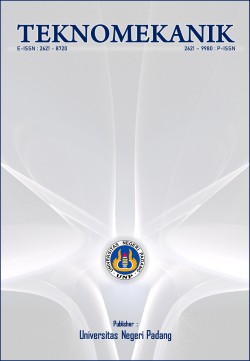Batang bayang river flood modeling based on rain return period
DOI:
https://doi.org/10.24036/jptk.v6i1.31723Keywords:
Flood, River, Rain Period, Batang BayangAbstract
West Pasaman Regency is one of the regencies in West Sumatra that experiences flooding the most. In 2020, in April and September, floods occurred in the West Pasaman district, more precisely around the Nagari Ujung Gading area, Lembah Melintang District. Floods most often inundate the Jorong Lombok and Jorong Irian areas. The flood that occurred was caused by the overflow of the Batang Bayang river. Puddles of water inundated at least 150 residents' houses until the water level reached a height of 1 meter. The problem of flooding almost every year is felt by residents who live near the location of the Batang Bayang river. This study aims to determine the flood discharge of the Batang Bayang river with return periods of 2, 5, 10 and 25 years. Then this study also aims to determine the ability of the Bayang Bayang River to flow flood discharge for 2, 5, 10 and 25 years return periods. The results show that the 2-year return period produces a maximum flood discharge of 47.2 m/s3. In the 5-year return period it produces a flood discharge of 110 m/s3, in the 10-year return period it produces a flood discharge of 143.6 m/s3 and at the return period of 25 years resulted in a flood discharge of 189.2 m3/s. The cross section modeling in the 2 year return period resulted in a water elevation of 21.07 meters. The 5-year return period modeling results in a water level elevation of 22.4 meters. The 10-year return period models the water at an elevation of 23.01 meters and the 25-year return period produces a water level of 23.72 meters.
Downloads
References
Mawardi Erman. 2007. Desain Hidrolik Bangunan Irigasi. Bandung: Alfabeta Bandung
Suripin. 2003. Sistem Drainase Perkotaan Berkelanjutan. Yogyakarta: ANDI
Direktorat Sungai, Ditjen Pengairan, Departemen Perkerjaan Umum. 1994. Teknologi Pengendalian Banjir Di Indonesia. Departemen Perkerjaan Umum
Arif Muhammad. 2019. Analisis Wilayah Berpotensi Banjir Daerah Sumatera Barat Untuk Pelaksanaan Pembelajaran Geografi Berorientasi Bencana Alam. Jurnal Kepemimpinan dan Kepengurusan Sekolah
Mulyadi Muhammad. 2011. Penelitian Kuantitatif dan Kualitatif dan Pemikiran dasa menggabungkannya. Jurnal Studi Komunikasi dan Media.
Natakusuma Dantje. 2011. Prosedur Umum Perhitungan Hidrograf Satuan Sintetis dengan Cara ITB dan Beberapa Contoh Penerapannya. Jurnal Teknik Sipil.
Kodoatie Robert. 2009. Hidrolika Terapan Aliran Pada Saluran Terbuka Dan Pipa.Yogyakarta: Andi
Basuki dkk. 2009. Analisis Periode Ulang Hujan Maksimum Dengan Berbagai Metode. J.Agromet 23 (2): 76-92
Palar dkk. 2013. Studi Perbandingan Antara Hidrograf Scs (Soil Conservation Service) Dan Metode Rasional Pada Das Tikala. Jurnal Sipil Statik Vol 1. No.3
Sari, Irawan. 2021. Penerapan Metode Empiris Di Das Batang Lembang Untuk Perhitungan Debit Banjir Rancangan. Akselerasi: Jurnal ilmiah Teknik Sipil Vol.2 No.2.
Siby, Halim. 2013. Studi Perbandingan Hidrograf Satuan Sintetik Pada Daerah Aliran Sungai Ranoyapo. Jurnal Sipil Statik Vol.1 No.4
Triatmodjo, Bambang. 2015. Hidrologi Terapan. Yogyakarta: Beta Offset Yogyakarta.
Haan Charles. 1977. Statistical Methods In Hydrology. Iowa: The Iowa State University Press.
HEC, 2002, HEC RAS Application Guide, US Army Corps of Engineer, Davis, California.
HEC, 2002, HEC RAS Hydroulic Reference Manual, US Army Corps of Engineer, Davis, California.
Soewarno. 1995. Hidrologi Aplikasi Metode Statistik Untuk Analisa Data. Bandung: Nova
Soedarsono, Takeda. 2003. Hidrologi Untuk Pengairan. Jakarta: Paradnya Paramita.
Syarifudin. 2017. Hidrologi Terapan. Yogyakarta: Andi.
Downloads
Published
How to Cite
Issue
Section
License
Copyright (c) 2023 Jonni Mardizal, Yaumal Arbi, Ikhsanul Akmal

This work is licensed under a Creative Commons Attribution 4.0 International License.





